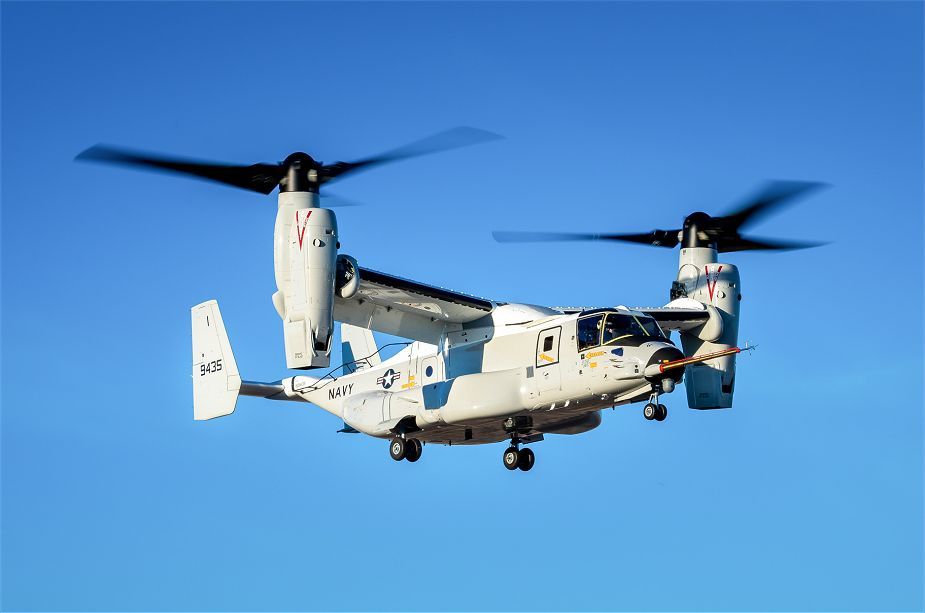Breaking news
US Navy CMV-22B Carrier Onboard Delivery variant of Osprey operational test in real-world environment.
The recent cross-country flight of the Navy’s new CMV-22B Carrier Onboard Delivery (COD) variant of the Osprey tilt-rotor aircraft was not only a milestone for the program, but also proved to be a perfect opportunity to demonstrate the effective fusion of development and operational test in a real-world environment.
 CMV-22B Carrier Onboard Delivery (COD) variant of the Osprey tilt-rotor aircraft. (Picture source Boeing)
CMV-22B Carrier Onboard Delivery (COD) variant of the Osprey tilt-rotor aircraft. (Picture source Boeing)
Over a two-day flight totaling just over 6.5 hours in the air, pilots LCDR Steve “Sanchez” Tschanz of Air Test and Evaluation Squadron (HX) 21 “Blackjacks” and CDR Kristopher “Junk” Carter of Air Test and Evaluation Squadron (VX) 1 “Pioneers” and crew chief Naval Aircrewman (Mechanical) 1st Class Devon Heard flew the first CMV-22B from the Bell Military Aircraft Assembly & Delivery Center in Amarillo, Texas, to Naval Air Station Patuxent River in early February. It was the first flight of the aircraft outside of the manufacturer’s test area, and it mirrored many of the conditions that the aircraft will encounter when operational.
The role of developmental testing, which is the mission of HX-21, is to identify whether an aircraft or system meets the promised specifications. Operational testing, which is what VX-1 does, focuses on the ability of an aircraft or system to operate in the environments that it will encounter once it is deployed to the fleet. Prior to the flight, Tschanz, Heard, Bell test pilot Andrew Bankston, and Naval Air Crewman (Mechanical) 2nd Class Trenton Olsheski conducted a series of developmental test flights to ensure the aircraft met its specifications. Following those test flights, it was time to deliver the aircraft to its new home at NAS Patuxent River.
The Osprey’s high-visibility paint scheme, which the Navy uses to help make it easier to identify noncombatant aircraft – and which, Tschanz joked, was more flattering than the usual matte blue-gray paint on the aircraft’s bulkier profile – certainly was part of the attraction when the aircraft landed in Millington, where the Naval Support Activity Mid-South base is located.
The CMV-22B is designed to carry up to 6,000 pounds of cargo and/or personnel and operate up to a range of 1,150 nautical miles. One of the reasons the Navy selected the V-22 airframe to serve in the COD role is because of its ability to carry the Pratt & Whitney F135 engine power module used by the F-35C Lightning II Joint Strike Fighter.
Other features of the CMV-22 include a beyond-line-of-sight, high-frequency radio system, and internal public-address system to communicate with passengers, and an improved lighting system to assist with cargo loading.
The Navy’s program of record is to acquire 48 aircraft across all VRM squadrons to serve as replacements for the venerable C-2A Greyhound, which has been fulfilling the COD role since 1966. Fleet Logistics Multi-Mission Squadron (VRM) 30 “Titans,” based on the West Coast of the United States, will take possession of its first CMV-22B this summer, and is scheduled to field the Ospreys on its first operational detachment aboard the USS Carl Vinson (CVN 70) later next year.
A new squadron, Fleet Logistics Multi-Mission Squadron (VRM) 40, will be established on the East Coast, will take possession of its aircraft beginning in FY2022. The Navy also plans to stand up a training squadron, Fleet Logistics Multi-Mission Squadron (VRM) 50, in California adjacent to VRM-30.



























